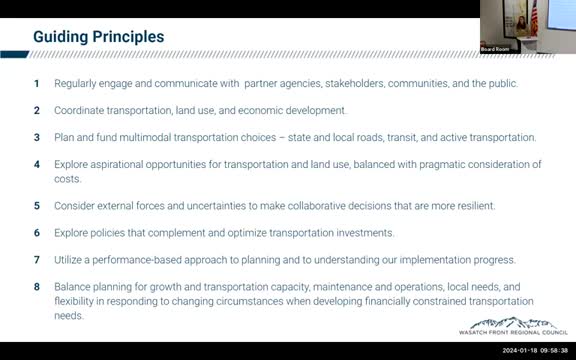Salt Lake City moves forward with ambitious transit station plans
January 18, 2024 | Regional Growth Technical Advisory Committee, Wasatch Front Regional Council, Wasatch County Commission and Boards, Wasatch County, Utah

This article was created by AI summarizing key points discussed. AI makes mistakes, so for full details and context, please refer to the video of the full meeting. Please report any errors so we can fix them. Report an error »

In a recent government meeting, officials discussed the certification of 13 stationary plans for transit stations in downtown Salt Lake City, a critical step in accommodating regional growth and enhancing public transportation infrastructure. The meeting highlighted the importance of these plans under House Bill 462, which mandates cities to develop stationary plans around transit stations while maintaining local control over land use.
Megan Townsend, a representative from Salt Lake City, provided an update on the progress of stationary planning, noting that Salt Lake City has been proactive in implementing transit-oriented development (TOD) strategies for years. The city has submitted resolutions for certification of the 13 stations, which include key locations such as 900 South, Temple Square, and Salt Lake Central. Currently, four plans have already been certified, with the potential for more following the council's approval.
The meeting also emphasized the goals of stationary planning, which include increasing housing availability and affordability, promoting sustainable environmental practices, and enhancing transportation options. Salt Lake City has made significant strides in these areas, with ongoing projects like the ambitious Green Loop, aimed at creating public open spaces and improving active transportation routes by 2034, coinciding with the upcoming Winter Olympics.
Nick Norris, the planning director for Salt Lake City, underscored the city's historical commitment to planning and development, stating that Salt Lake City has been implementing policies aligned with stationary planning objectives for over a century. He highlighted recent zoning changes, including the removal of parking minimums in downtown areas, to facilitate development and support local businesses.
The council also addressed how smaller cities can utilize stationary planning principles, emphasizing the flexibility of the legislation to adapt to various community contexts. Officials encouraged collaboration and outreach to assist smaller municipalities in developing their own plans tailored to local needs.
Overall, the meeting underscored Salt Lake City's proactive approach to urban planning and development, positioning the city as a model for effective transit-oriented growth in the region.
Megan Townsend, a representative from Salt Lake City, provided an update on the progress of stationary planning, noting that Salt Lake City has been proactive in implementing transit-oriented development (TOD) strategies for years. The city has submitted resolutions for certification of the 13 stations, which include key locations such as 900 South, Temple Square, and Salt Lake Central. Currently, four plans have already been certified, with the potential for more following the council's approval.
The meeting also emphasized the goals of stationary planning, which include increasing housing availability and affordability, promoting sustainable environmental practices, and enhancing transportation options. Salt Lake City has made significant strides in these areas, with ongoing projects like the ambitious Green Loop, aimed at creating public open spaces and improving active transportation routes by 2034, coinciding with the upcoming Winter Olympics.
Nick Norris, the planning director for Salt Lake City, underscored the city's historical commitment to planning and development, stating that Salt Lake City has been implementing policies aligned with stationary planning objectives for over a century. He highlighted recent zoning changes, including the removal of parking minimums in downtown areas, to facilitate development and support local businesses.
The council also addressed how smaller cities can utilize stationary planning principles, emphasizing the flexibility of the legislation to adapt to various community contexts. Officials encouraged collaboration and outreach to assist smaller municipalities in developing their own plans tailored to local needs.
Overall, the meeting underscored Salt Lake City's proactive approach to urban planning and development, positioning the city as a model for effective transit-oriented growth in the region.
View full meeting
This article is based on a recent meeting—watch the full video and explore the complete transcript for deeper insights into the discussion.
View full meeting

